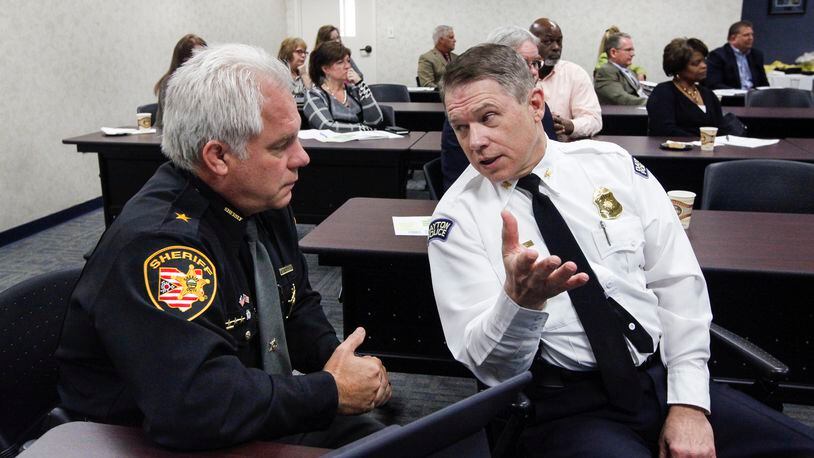No blueprint existed when Dayton began attacking this problem five years ago, said Betsy Pearl, the center’s campaign manager for criminal justice reform.
“We really hope that this report will serve as a road map,” she said.
The strategies described in the report include:
- Providing harm reduction services, such as syringe exchange programs. "These services are integral to saving lives and reducing the spread of disease," the report says.
- Treating addiction as a disease, not a crime. "This requires educating all stakeholders on the nature of the disease, including the likelihood of relapse, to ensure interventions reflect this understanding," the report says.
- Purposeful and rapid data collection, distribution and analysis to drive effective responses.
- Breaking down barriers between community members, government agencies, county and city officials, businesses and nonprofits to allow a coordinated effort.
- Combating the stigma of addiction within the community.
- Leveraging an emergency management approach to create the Community Overdose Action Team (COAT).
Preliminary numbers from the Montgomery County Coroner’s Office show the county recorded 294 overdose deaths in 2018, down from 566 the year before.
For many individuals and organizations, it required stepping out of their traditional roles and comfort zones, the report says. Data was key to getting everyone to recognize the cost to the community of doing nothing, Mayor Nan Whaley told the Dayton Daily News. She co-wrote the introduction to the report.
Everyone has to be on the same page, Whaley said, in recognizing that mental health and addiction are a public health crisis.
“If you’re other communities looking at this, I think you come away with there isn’t just one silver bullet,” she said.
Tracking an epidemic
The report chronicles how Dayton’s efforts initially developed through a lot of trial and error.
Years before overdose deaths spiked in 2017, the city and various human services organizations noticed how drug addiction was affecting neighborhoods. The east side of Dayton in particular experienced a crime wave.
“We had looked at the data and we felt that property crime was the big issue,” said Jan Lepore-Jentleson, executive director of East End Community Services.
A federal grant in late 2012 provided for an analysis of police data, which she said revealed a startling statistic.
The Path Forward: Addiction in Dayton
- » Millions of tax dollars pay for new drug treatment -- is it working?
- » Program examines if fentanyl test strips reduce overdoses, save lives
- » Dayton getting national credit for battling opioid crisis
- » Vets twice as likely to fatally OD -- what the Dayton VA is doing about it
- » ‘Life Changing Food’: This eatery hires only people recovering from addiction
- » New challenge for recovering addicts: Finding a job
- » Can Dayton go from 'overdose capital' to a model for recovery?
- » Mother of 7 rebuilding family after addiction
- » A day with Dayton's overdose response team
“Ninety two percent of the people that they had arrested over a certain period of time were heroin addicts,” Lepore-Jentleson said. “That was the ‘A-ha’ moment.”
From there, the partnership between East End and the police department started working to identify individuals in need of services and connect them to treatment — activities that would eventually lead to the formation of Conversations for Change, Dayton’s Mobile Crisis Response Team, Getting Recovery Options Working blitzes and other ongoing efforts.
“The partnership’s efforts became the backbone of the city’s response to the epidemic,” the report says. “The police department’s willingness to step out of traditional roles and into addiction support helped shift the DPD culture and inspire others to innovate.”
That willingness by the city to experiment was key, Lepore-Jentleson said, as some other institutions were slower to respond.
“We were pretty frustrated for the first couple of years as the deaths continued to go up,” she said.
It wasn’t until 2016 when the COAT came together.
Lepore-Jentleson’s advice for other communities is to not wait too long to partner government agencies with grassroots innovation.
“Be willing to experiment and don’t wait for the best practices manual to come out,” she said.
Personal connection
The author of the report is Erin Welch, who came to work with the city of Dayton last summer as part of her Master’s of public policy and management program at Carnegie Mellon University. She graduated from the school in December.
She dedicated the report to the memory of her brother, Sean Francis Welch, who died of an overdose in Cleveland in January 2018.
After Welch wrote the report, Whaley said the city reached out to the Center for American Progress, a policy organization that she has worked with through the Mayors for Smart on Crime group.
The center wanted to distribute the report nationally, Pearl said.
“Dayton’s approach is just so unique, we wanted to make sure it gets a national audience,” she said.
ABOUT THE PATH FORWARD
Like all of you, we care deeply about our community and want it to be the best it can be. We have formed a team to dig into the most pressing issues facing the Miami Valley. The Path Forward project, with your help and that of a 16-member community advisory board, seeks solutions to issues readers told us they were most concerned about.
Follow the project at DaytonDailyNews/PathForward and share your ideas on our Facebook pages.
About the Author
